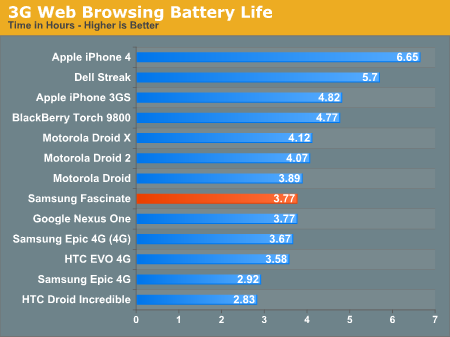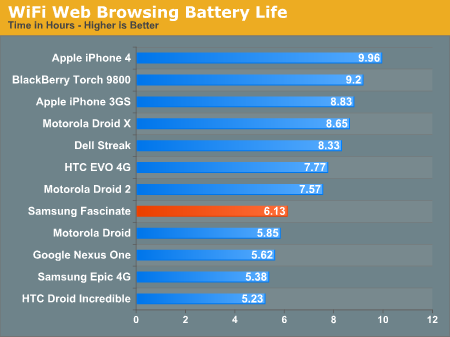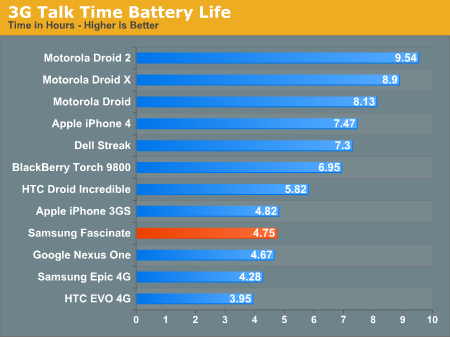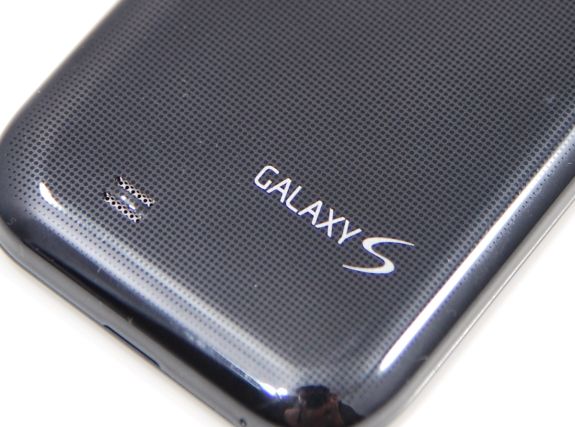Samsung Fascinate Review: Verizon's Galaxy S Smartphone
by Brian Klug on October 5, 2010 12:01 AM EST- Posted in
- Smartphones
- Samsung
- Galaxy S
- Fascinate
- Mobile
Speakerphone Volume
We've been testing speakerphone volume regularly on devices using a decibel meter 6" away from the device turned face up. In addition, we've been testing audio quality subjectively. The Fascinate is decently loud.

There's a raised bit right over the speaker output, so sound makes it out and around even if you've got the phone laying on a flat surface.
Earpiece performance and volume is adequate - voice quality is as good on the Fascinate as I've seen on other CDMA handsets in the testing I performed. One place I noticed the Fascinate being a bit quieter than I would've liked was Google Navigation.
Battery Life
The Fascinate doesn't really set any records for battery life, but then again that's partly due to the combination of Super AMOLED and the more power hungry SGX 540. For 3G and WiFi web browsing battery life tests, we run through a series of just over 20 pages every 10 seconds with the screen set at 50% brightness until the device dies. Obviously during 3G testing, WiFi is disabled. During WiFi testing, cellular is enabled. Background applications are also all killed before launching the browser and starting our test. For call time testing, we initiate a call and play music on both ends and wait for the phone to die.
The Fascinate does best the Epic 4G quite handily though.



The Fascinate does have a relatively beefy 1500 mAh, 5.55 Whr removable battery (same as the Epic 4G), but it still doesn't come close to its brethren in some areas. It's still better than the Epic fared with its 4G stack, but it's hard to really nail down why battery life isn't quite as good as the competition, even its Android competition. Either way, it seems like the Fascinate is designed to compete with the Nexus One and Motorola Droid, where it comes close. It can't hold a candle to the Droid 2 or Droid X. Perhaps when we finally get the Captivate and Vibrant - each with GSM/UMTS stacks - we'll be able to tell more about where this battery life deficiency lies.











73 Comments
View All Comments
metafor - Tuesday, October 5, 2010 - link
That seems to be a common misconception. Just think about it, the processor is somewhere around ~500mW doing an intensive task. Compare that to an RF radio chip that eats 2W or so while communicating to a 3G cell tower. Or the 2-3W display....The App Processor is a small percentage of overall power draw.
strikeback03 - Tuesday, October 5, 2010 - link
Agreed, checking the power usage utility on Android it isn't uncommon to see the screen drawing the vast majority of the power. Which AMOLED has the potential to help with if there were a way to format websites to be more friendly to it (i.e. no white backgrounds).metafor - Tuesday, October 5, 2010 - link
I'm personally banking on either Pixel Qi or Mirasol improving to the point where they can take over being the displays used. The power savings would warrant any apparent difference in image quality as long as it's "good enough".JimmiG - Wednesday, October 6, 2010 - link
"Just think about it, the processor is somewhere around ~500mW doing an intensive task. Compare that to an RF radio chip that eats 2W or so while communicating to a 3G cell tower. Or the 2-3W display...."I guess you're right. I can play games and watch video on my HTC Desire without using much battery, but 3G browsing absolutely kills battery life. My daily routine involves heavy 3G web browsing on the 1-hour commute to school by train, then the phone spends most of the day in standby, then another hour of heavy usage on the way home in the afternoon. This is enough to run the battery down to ~10% by the time I get home, if I'm lucky enough to have it last the whole day.
But then, how does the iPhone4 manage nearly 7 hours of 3G browsing? Does it use a different radio chip, is it the network, or what?
metafor - Wednesday, October 6, 2010 - link
RF chips don't really vary that much. I would take a guess that it's good software management. What you don't realize is that most of the time you're browsing, you're not actually loading data. You have a burst of data as the website loads, but then it stops.I've noticed on my iPhone that periods of inactivity -- while I'm reading a webpage -- would cause the signal bar to drop a bit. It would go back up once I clicked on a link.
I suspect the software is putting the RF chip in a low-power mode more aggressively than HTC equivalents.
A lot of people discount it but software throttling is the single-most effective way of reducing power consumption.
ssj4Gogeta - Tuesday, October 5, 2010 - link
Is there any chance you'll do an I9000 review? It's the European/Asian version of the Galaxy S. It comes unlocked, doesn't have loads of crap preinstalled, and trades the LED flash for a front VGA cam. It also doesn't have a search button, but you can long-press the menu button to search.Also, please consider trying the voodoo lag fix in your future Galaxy S reviews.
http://project-voodoo.org/
It basically changes the system partition file system from RFS to EXT4, which makes the phone noticeably faster and smoother (no stalling while installing apps, no stuttering..)
8steve8 - Tuesday, October 5, 2010 - link
i personally have an international galaxy s with beta froyo rom (JPK), with lagfix, these are the numbers i get:Rightware BrowserMark:
35345 : my galaxy s 2.2
29018 : fascinate 2.1
sunspider:
07375.8ms : my galaxy s 2.2
15835.0ms : fascinate 2.1
linpack:
14.399 MFLOPS : my galaxy s 2.2
08.157 MFLOPS : fascinate 2.1
NeoCore Benchmark:
55.6FPS : my galaxy s 2.2
55.6FPS : fascinate 2.1
quadrant:
2000ish : my galaxy s 2.2 w/lagfix
0800ish with my galaxy s 2.1 stock
the phone ships with a terrible filesystem setup, causes severe lag over time... as shown in the quadrant score which does some IO stuff... this is fixable with root and a lagfix app...
and gps works about as good as my nexus one
(although in 2.1 builds of the firmware GPS was terrible)
this has been said by everyone, but the 4" SAMOLED displays on these things are sick... makes a nexus one display look really dated, and although props to the iphone for finally getting hi-res, 3.5" just seems comparably too small.
annoying it shipped so broken, but once dealt with, a beautiful device and over-all experience
ssj4Gogeta - Wednesday, October 6, 2010 - link
You don't even require root for voodoo lagfix. It comes in an update.zip and changes the filesystem to ext4.webmastir - Tuesday, October 5, 2010 - link
fantastic review. this is why i love this site! great job & great info.Shadowmaster625 - Tuesday, October 5, 2010 - link
If you can forget that a $500+ piece of hardware is in your pocket, then you need to be... outsourced.